No products in the cart.

Home » Form Follows Function – Part 2: Canine Structure and Movement
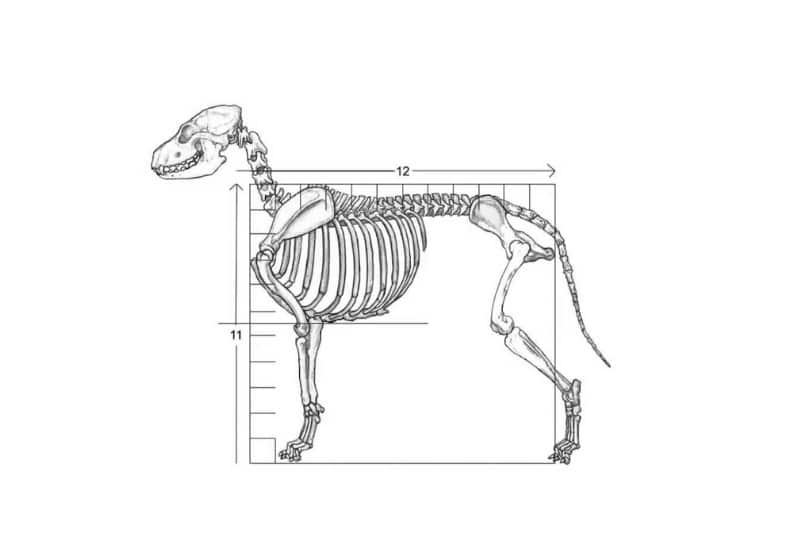
In this segment of the “Form Follows Function” articles we will look at how movement is an integral component of breed character and begin to discuss some of the basics of canine structure. From here, we will move on to how the correctly structured dog should move and will wrap up with how to start to discover the essential breed characteristics in your breed.
By the fact that you are reading this article, I know that you are part of the dog fancy or that you have a deep interest in dogs. You probably show dogs and may also breed them. As “show breeders,” we must realize that WE ARE OUR BREED’S ONLY KEEPERS. We are the only ones who can be called upon to be responsible for maintaining our chosen breed’s innate qualities—the essence of the breed.
You must know the essential characteristics without which your dog would be difficult to recognize as a specific breed. What makes it a Cardigan Welsh Corgi and not a Pembroke Welsh Corgi? An English Setter, not a Gordon Setter?
As “show breeders,” we must realize that WE ARE OUR BREED’S ONLY KEEPERS.
First, you must pull out the Standard for your breed. The Standard is the blueprint (an abstract) that defines in words the boundaries within which a dog can be considered correct for its breed. A written description cannot convey information in the same way as an illustration or a video clip, but it is a great place to start you on your journey in understanding breed type. Study it, analyze it, and memorize it!
In addition to your Standard, you must learn the daily tasks your breed was expected to perform, the terrain over which the breed had to work, and the climate in which he performed his duties. Studying the history of a breed is also essential to understanding it. It is my objective for you to be able to determine which dog is most likely to stay sound the longest while doing his daily job. We must understand that all dogs have faults. As breeders, we must learn which faults each of our dogs possesses in order to try to correct them in the next generation.
The judge gets off much easier; they only have to know the dog has a fault, not what causes it or how to fix it. Judges must only know how to weigh the dog’s faults against its virtues, and their only goal is to reward the dog with the most virtues that can function the best to fulfill the breed’s purpose. It is our job as breeders to know what causes the faults and how to fix them through judicious selection of a mate that will contribute to correcting your dog’s faults without sacrificing her (or his) virtues. If your dog lacks breed type, then it doesn’t matter HOW it moves!
I am going to touch on the basic structure one should expect to find in the ‘average’ breed of dog. I will then make some reference to the differences between several breeds. It is impossible to cover every breed in this series. I am hoping that what you see here will stimulate you to explore the unique qualities of your own breed. By studying many breeds, you learn more about your own—the similarities and the differences—so that as a breeder, you will know which characteristics you MUST preserve in your breed and in your own dogs.
Discussions on structure usually center on the skeletal system for a reason. The skeleton is the framework upon which the muscles, tendons, and ligaments are built to provide locomotion for the dog and to serve as a means of protecting the internal organs. For the most part, the composition of the skeleton dictates the movement of the dog. We are well aware that the skeleton is simply bones and has no means of creating movement on its own. Muscles move the bones, and it is obvious that without muscles, there is no movement.
Unfortunately, the musculature of the dog is a complicated subject, too lengthy for us to address here. Therefore, we are simply going to try to understand the structural composition of the skeleton and its joints and their effects on movement in the dog, leaving the study of the muscles of the dog up to the individual student.
The skeleton of the basic or average dog. Slightly longer than tall with distance from withers to elbow approximately equal to the distance from elbow to ground. Brisket (bottom of chest) descends to elbow.

Every dog has the same number and kind of bones. What varies are the length of the bones and the angles at which they join, which differ from breed to breed and also from dog to dog within each breed. Bones are the building blocks of structure. Bones are classified according to shape and function. Long bones (the limbs) act as support columns. Short bones diffuse concussions in limbs when the dog runs or lands from a jump.
One of the functions of the bones is to supply a sufficient area for the attachment of muscles. Smooth muscles account for approximately one-third to one-half of the total body weight. Ligaments hold bones together, while tendons attach muscles to bones. Tendons are considered to be a part of the muscle structure; ligaments are not.
Angulation refers to the angles created by bones meeting at various joints (articulations), especially at the shoulder, upper and lower leg, the pelvic area, and the stifle, hock, and pastern. Bones meet one another in different kinds of joints, allowing different degrees and types of movement.
There are three basic canine joint types: the ball and socket joint, such as the hip and shoulder joints; the hinge joint, such as the elbow and knee joints; and the plane joint, such as the wrist and ankle joints. The joints are lubricated for smooth action by synovial fluid and are stabilized by tendons and ligaments.
Once more, structure and movement are inextricably linked. Without correct structure, good movement is not likely to happen.
The center of gravity in the dog is that point at which the entire weight can be considered concentrated. In the average dog, this weight center is generally slightly back and below the upper tips of the shoulder blades. Indicated by the black dot on Figure 2.
This center of gravity can vary from breed to breed, mostly depending upon the weight of the head and forequarters when compared to the rest of the dog. Much of the efficiency of the dog in motion is dependent upon the location and shifting of the center of gravity.
Since 60% of the weight of the dog is concentrated on the front (due to the head and neck), the front assembly of the dog is of vital importance to the function of the dog as a whole.
Most of this weight is flexibly carried by the forelimbs, using ONLY muscles and tendons.
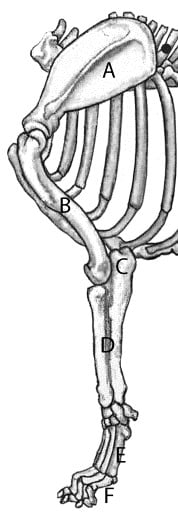
The upper, larger edge of the shoulder blade is slightly below the spines of the spinal (vertebral) column. The shoulder blade has no joint connection with the upper chest and spine but lies between them and is fused to a flat muscle attached at the 3rd–9th vertebrae.
The articulation of the shoulder blade with the upper arm forms the shoulder joint.
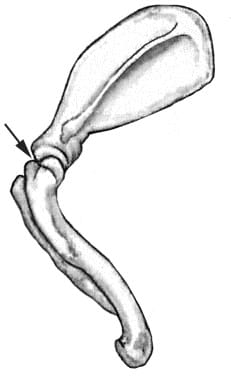
The shoulder blade (scapula) lies ideally at a 45-degree angle to the ground against the upper front section of the chest (thorax), with the lower forward point (joint) at about the first rib or frontal opening of the chest. From the point of the shoulder, the angle between the blade and the upper arm is perceived to be approximately 90 degrees.
The 90-degree angle formed by the shoulder joint enables the dog to stand well over its forelimbs due to the return of the upper arm to the elbow, which in the average dog is set in a line under the withers.
Layback of shoulder blade and tilt of pelvis determine forward reach in front, under reach, and rear drive behind.
It is extremely important to understand that, whereas the rear assembly is attached via the articulation of the upper thigh (femur) at the hip (pelvis), the forelimbs of the dog have no skeletal attachment to the chest (thorax), only a muscular attachment. The shoulder blade is bound to the body by several broad, flat muscles. At the lower end of the shoulder blade is the upper arm (humerus), which is fairly free in movement, though it is attached to the chest (thorax) by several muscles.
The layback of the shoulder blade determines the front reach of the dog. The angulation can be determined when physically examining a dog and depends on certain “landmarks” or points where the bones may be felt through the coat, skin, muscles, and fat of the dog being examined.
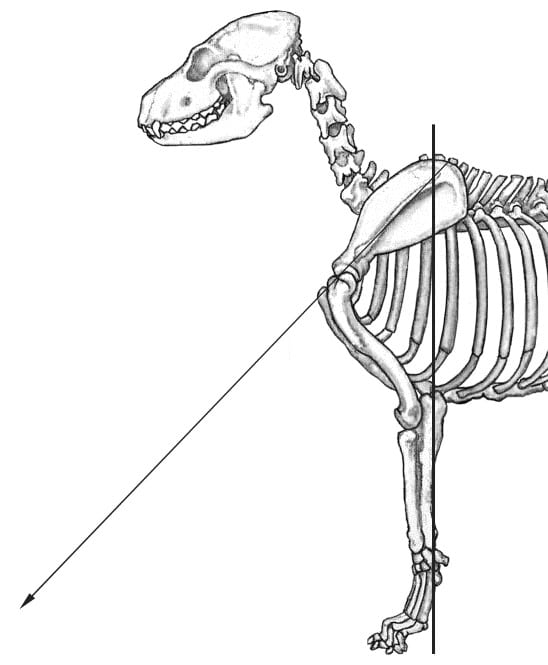
On the shoulder assembly, the easily felt landmarks are the spine of the scapula (A) and the ‘notch’ formed where the shoulder blade meets the upper arm (B). The point of the shoulder is actually the top of the upper arm (C).
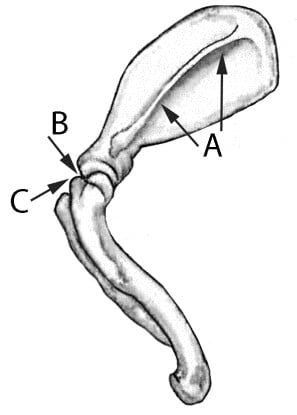
The upper arm is approximately equal or somewhat longer in nearly all but the dwarf breeds. The body of the upper arm (humerus) makes approximately a 90-degree angle with the spine of the scapula as it returns back to articulate with the leg bones at the point of the elbow. From the point of the shoulder, the angle between the blade and the upper arm is perceived to be approximately 90 degrees.
By perceived, I mean that using the landmarks available to us when physically examining a dog, the optimum layback of the shoulder blade for most breeds is a 45-degree angle to the ground. To place the leg up under the body, a 90-degree angle formed by the juncture of an upper arm of the correct length to the shoulder blade would place the leg back under the body with the elbow approximately beneath the highest point of a well-laid back shoulder blade.
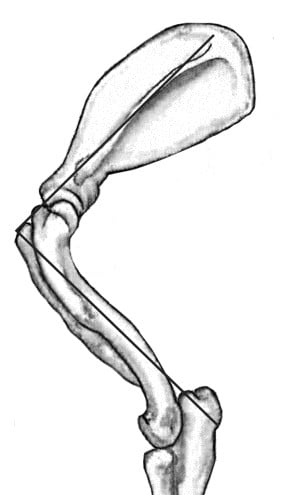
Ideally, the highest part of the shoulder blade lies just below the level of the 1st and 4th vertebrae, with the spine of the shoulder blade pointing to the highest part of the blade.
In the majority of breeds, the upper arm is the largest bone in the forearm assembly, and even though most Standards call for an upper arm length as long as the shoulder blade, it is, for most breeds, actually longer than the shoulder blade. Again, the point of the shoulder usually referred to in measuring body length is actually the upper end of the upper arm.

In the majority of breeds, the upper arm is the largest bone in the forearm assembly, and even though most Standards call for an upper arm length as long as the shoulder blade, it is, for most breeds, actually longer than the shoulder blade.
To complete the fore assembly of the dog, from the all-important shoulder blade-upper arm angle, the upper arm then returns back under the body to join with the forearm (ulna C and radius D) at the elbow joint (olecranon) B. The forearm is attached to the upper arm at the elbow joint at an angle of approximately 135 degrees between the upper arm and the forearm. Directly below the forearm is the pastern joint (carpals), which is the equivalent of the wrist joint in humans. The front pasterns (metacarpals) F are the equivalent to the bones in our hands. The paw joint G joins the front pastern to the front paw of the dog (phalanges are equivalent to human fingers) H, which end in the toenails.
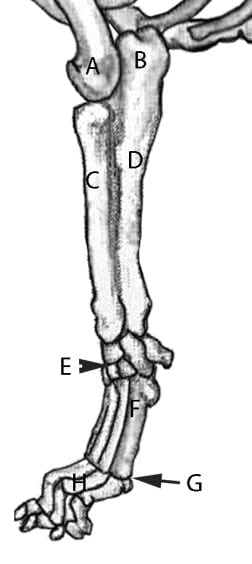
The next installment will deal with the structure of the hindquarters and a bit about the head, neck, and spinal column. This should give us a basic understanding of the skeletal structure of the dog that we can relate to the shape and movement of the dog in the following installments.
Form Follows Function: Part Two. From the February 2019 Issue of Showsight Magazine.
This series originally appeared in the Working/Herding Digest. All rights reserved by the author. This series originally appeared in the Working/Herding Digest. All rights reserved by the author.
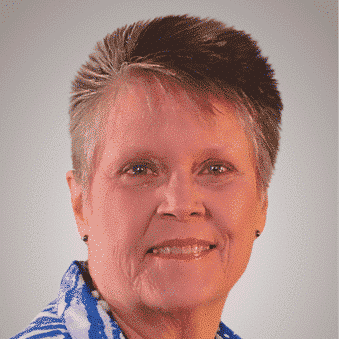
Notifications